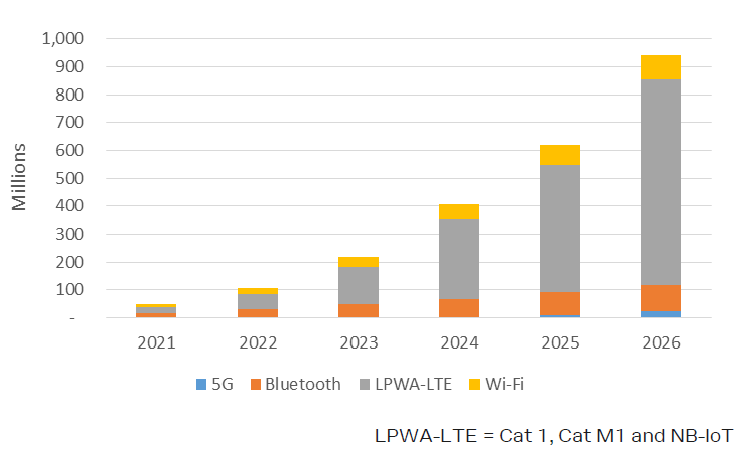
- Support portal
- Evaluation Kits and partner products
u-blox Support
- Product documentation
Documentation
- Investor relations
Investor relations
Insights
|
09 Oct 2020
Wireless technologies will help manufacturing plants tap into the value of the data they collect. For many use cases, existing technologies offer a perfect starting point.

Our manufacturing industry is moving to a stage where automation no longer relies solely on programmable logic controllers, but is supplemented by more sophisticated and complex cyber-physical systems with far greater connectivity to sensors and other component parts. The advent of Industry 4.0 brings smart automation, which uses data captured from a multitude of distributed IoT sensor nodes in conjunction with the latest cloud-based services.
Optimizing every aspect of the manufacturing process will help boost productivity levels, reduce wastage, and curb operational expenditure. Alongside that, predictive maintenance maximizes uptime and avoids unplanned and costly shutdowns. Wireless communication technology is set to play a significant role in this digital transformation; however, the choice of which protocol to use will depend on the application requirements.
Breaking down silos brings closer integration of the operational elements within a business. Access to the data sets compiled will help with asset management, ensure full use of all available resources, and better organize logistical activities. It will be possible to make the manufacturing site’s systems more responsive to potential issues that arise through such data.
Having correct and timely information will also assure the continued safety of the workforce situated there. From a diagnostic/analytical perspective, this data will show trends or patterns within the facility – some good, others bad. A minor process alteration, for example, may help improve yields, enhance the end-product quality, or extend the working lifespan of production equipment.
Acquiring this data through wireless connectivity is much more attractive than taking a wireline approach. It is easier and cheaper to deploy, has greater implementation flexibility, and can be scaled up as required. Based on ABI Research analysis, Figure 1 gives details on the wireless technology being incorporated into IoT nodes. For the next few years, the predominant technologies will be cellular IoT, Bluetooth, and Wi-Fi. However, in about 4-5 years, 5G SA and uRLLC will start to gain traction.

Figure 1: Number of deployed IoT connections [Source ABI Research].
Wi-Fi 6 (802.11ax) - Expected to displace 802.11ac, which only utilizes the 5 GHz frequency band, Wi-Fi 6 additionally makes use of 2.4 GHz. In North America, the FCC will also open up the 6 GHz band, with Europe intending to follow this tactic too. Thanks to OFDMA technology, Wi-Fi 6 can support communication with a far greater number of connected nodes and deliver much faster data throughput (due to MU-MIMO).
Bluetooth 5 – Bringing a significant increase in data rate and transmission range compared to previous generations, Bluetooth 5 consumes much less power per bit. It can support certain location-based services, which could be of interest in an industrial IoT context – with the introduction of the Bluetooth 5.1 specification allowing the determination of direction. As a consequence, angle of arrival and angle of departure data can be made use of.
5G – Today’s cellular IoT is based on 4G protocols, such as NB-IoT and LTE-M. 5G new radio (NR) promises greater network capacity and elevated data rates, and support for ultra-low (sub-1-millisecond) latency operation. The resulting improvement in industrial automation infrastructure responsiveness, generally through private networks implementations, will be of enormous value. It will enable better control of robotics and automated guided vehicles from remote locations.
With the advent of 5G, there will also be scope to ramp up the number of connected nodes within a given area, diminishing the power consumed by individual nodes. Nevertheless, there will still be a place for NB-IoT and LTE-M to contribute to tomorrow's manufacturing facilities for applications that do not require such high performance or where cost is a concern. Waiting for 5G to arrive before embarking on smart factory implementations is not an advisable tactic to follow for predictive maintenance and remote monitoring use cases.
Leveraging IoT today, manufacturers will still be able to gain significant competitive advantages. Many of the key use cases can be addressed by wireless technologies that are already available with the more advanced technologies needed for ultra-reliable and deterministic operation coming soon.
Deployed wireless hardware must offer ongoing operational longevity (as IoT nodes may be situated in difficult to reach locations). Therefore, both reliability and efficient battery use are critical. In many use cases, they will need to support decade-long operation. Out-of-the-box solutions that are simple to implement and subsequently configure will be the most attractive, as will ones that offer ease of integration with the leading cloud service providers’ technologies. Backward compatibility will also be of value.
Also of prime importance is the security and protection of the transmitted data from malicious third parties. There should also be fully effective anti-cloning mechanisms in place. Via platforms like SARA-R5 and SARA-R4, LARA, ANNA, NINA and JODY, u-blox offers a broad portfolio of solutions to meet both current and future IoT demands.
Watch our informative webinar ‘Next-Generation Wireless Connectivity for Industry 4.0’:

Ludger Boeggering
Senior Principal Application Marketing EMEA, Energy and Industry 4.0, u-blox
Pelle Svensson
Market Development Manager, Product Center Short Range Radio, u-blox